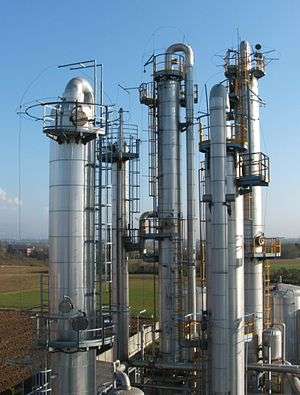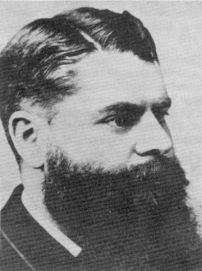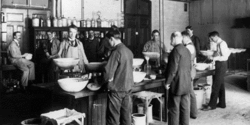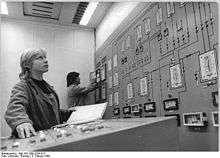Chemical engineering

Chemical engineering is a branch of engineering that applies physical sciences (physics and chemistry), life sciences (microbiology and biochemistry), together with applied mathematics and economics to produce, transform, transport, and properly use chemicals, materials and energy. Essentially, chemical engineers design large-scale processes that convert chemicals, raw materials, living cells, microorganisms and energy into useful forms and products.
Etymology

A 1996 British Journal for the History of Science article cites James F. Donnelly for mentioning an 1839 reference to chemical engineering in relation to the production of sulfuric acid.[1] In the same paper however, George E. Davis, an English consultant, was credited for having coined the term.[2] The History of Science in United States: An Encyclopedia puts this at around 1890.[3] "Chemical engineering", describing the use of mechanical equipment in the chemical industry, became common vocabulary in England after 1850.[4] By 1910, the profession, "chemical engineer," was already in common use in Britain and the United States.[5]
History
Chemical engineering emerged upon the development of unit operations, a fundamental concept of the discipline of chemical engineering. Most authors agree that Davis invented unit operations if not substantially developed it.[6] He gave a series of lectures on unit operations at the Manchester Technical School (later part of the University of Manchester) in 1887, considered to be one of the earliest such about chemical engineering.[7] Three years before Davis' lectures, Henry Edward Armstrong taught a degree course in chemical engineering at the City and Guilds of London Institute. Armstrong's course "failed simply because its graduates ... were not especially attractive to employers." Employers of the time would have rather hired chemists and mechanical engineers.[3] Courses in chemical engineering offered by Massachusetts Institute of Technology (MIT) in the United States, Owens College in Manchester, England, and University College London suffered under similar circumstances.[8]

Starting from 1888,[9] Lewis M. Norton taught at MIT the first chemical engineering course in the United States. Norton's course was contemporaneous and essentially similar with Armstrong's course. Both courses, however, simply merged chemistry and engineering subjects. "Its practitioners had difficulty convincing engineers that they were engineers and chemists that they were not simply chemists."[3] Unit operations was introduced into the course by William Hultz Walker in 1905.[10] By the early 1920s, unit operations became an important aspect of chemical engineering at MIT and other US universities, as well as at Imperial College London.[11] The American Institute of Chemical Engineers (AIChE), established in 1908, played a key role in making chemical engineering considered an independent science, and unit operations central to chemical engineering. For instance, it defined chemical engineering to be a "science of itself, the basis of which is ... unit operations" in a 1922 report; and with which principle, it had published a list of academic institutions which offered "satisfactory" chemical engineering courses.[12] Meanwhile, promoting chemical engineering as a distinct science in Britain lead to the establishment of the Institution of Chemical Engineers (IChemE) in 1922.[13] IChemE likewise helped make unit operations considered essential to the discipline.[14]
New concepts and innovations
By the 1940s, it became clear that unit operations alone was insufficient in developing chemical reactors. While the predominance of unit operations in chemical engineering courses in Britain and the United States continued until the 1960s, transport phenomena started to experience greater focus.[15] Along with other novel concepts, such process systems engineering (PSE), a "second paradigm" was defined.[16][17] Transport phenomena gave an analytical approach to chemical engineering[18] while PSE focused on its synthetic elements, such as control system and process design.[19] Developments in chemical engineering before and after World War II were mainly incited by the petrochemical industry,[20] however, advances in other fields were made as well. Advancements in biochemical engineering in the 1940s, for example, found application in the pharmaceutical industry, and allowed for the mass production of various antibiotics, including penicillin and streptomycin.[21] Meanwhile, progress in polymer science in the 1950s paved way for the "age of plastics".[22]
Safety and hazard developments
Concerns regarding the safety and environmental impact of large-scale chemical manufacturing facilities were also raised during this period. Silent Spring, published in 1962, alerted its readers to the harmful effects of DDT, a potent insecticide. The 1974 Flixborough disaster in the United Kingdom resulted in 28 deaths, as well as damage to a chemical plant and three nearby villages. The 1984 Bhopal disaster in India resulted in almost 4,000 deaths . These incidents, along with other incidents, affected the reputation of the trade as industrial safety and environmental protection were given more focus.[23] In response, the IChemE required safety to be part of every degree course that it accredited after 1982. By the 1970s, legislation and monitoring agencies were instituted in various countries, such as France, Germany, and the United States.[24]
Recent progress
Advancements in computer science found applications designing and managing plants, simplifying calculations and drawings that previously had to be done manually. The completion of the Human Genome Project is also seen as a major development, not only advancing chemical engineering but genetic engineering and genomics as well.[25] Chemical engineering principles were used to produce DNA sequences in large quantities.[26]
Concepts
| Part of a series on |
| Chemical engineering |
|---|
| Fundamentals |
| Unit processes |
| Aspects |
|
|
Chemical engineering involves the application of several principles. Key concepts are presented below.
Chemical reaction engineering
Chemical engineering involves managing plant processes and conditions to ensure optimal plant operation. Chemical reaction engineers construct models for reactor analysis and design using laboratory data and physical parameters, such as chemical thermodynamics, to solve problems and predict reactor performance.
Plant design and construction
Chemical engineering design concerns the creation of plans, specification, and economic analyses for pilot plants, new plants or plant modifications. Design engineers often work in a consulting role, designing plants to meet clients' needs. Design is limited by a number of factors, including funding, government regulations and safety standards. These constraints dictate a plant's choice of process, materials and equipment.[27]
Plant construction is coordinated by project engineers and project managers [28] depending on the size of the investment. A chemical engineer may do the job of project engineer full-time or part of the time, which requires additional training and job skills, or act as a consultant to the project group. In USA the education of chemical engineering graduates from the Baccalaureate programs accredited by ABET do not usually stress project engineering education, which can be obtained by specialized training, as electives, or from graduate programs. Project engineering jobs are some of the largest employers for chemical engineers.[29]
Process design and analysis
A unit operation is a physical step in an individual chemical engineering process. Unit operations (such as crystallization, filtration, drying and evaporation) are used to prepare reactants, purifying and separating its products, recycling unspent reactants, and controlling energy transfer in reactors.[30] On the other hand, a unit process is the chemical equivalent of a unit operation. Along with unit operations, unit processes constitute a process operation. Unit processes (such as nitration and oxidation) involve the conversion of material by biochemical, thermochemical and other means. Chemical engineers responsible for these are called process engineers.[31]
Process design requires the definition of equipment types and sizes as well as how they are connected together and the materials of construction. Details are often printed on a Process Flow Diagram which is used to control the capacity and reliability of a new or modified chemical factory.
Education for chemical engineers in the first college degree 3 or 4 years of study stresses the principles and practices of process design. The same skills are used in existing chemical plants to evaluate the efficiency and make recommendations for improvements.
Transport phenomena
Modeling and analysis of transport phenomena is essential for many industrial applications. Transport phenomena involve fluid dynamics, heat transfer and mass transfer, which are governed mainly by momentum transfer, energy transfer and transport of chemical species respectively. Models often involve separate considerations for macroscopic, microscopic and molecular level phenomena. Modeling of transport phenomena requires therefore requires an understanding of applied mathematics.[32]
Applications and practice


Chemical engineers "develop economic ways of using materials and energy".[34] Chemical engineers use chemistry and engineering to turn raw materials into usable products, such as medicine, petrochemicals and plastics on a large-scale, industrial setting. They are also involved in waste management and research. Both applied and research facets could make extensive use of computers.[33]
Chemical engineers may be involved in industry or university research where they are tasked with designing and performing experiments to create better and safer methods for production, pollution control, and resource conservation. They may be involved in designing and constructing plants as a project engineer. Chemical engineers serving as project engineers use their knowledge in selecting optimal production methods and plant equipment to minimize costs and maximize safety and profitability. After plant construction, chemical engineering project managers may be involved in equipment upgrades, process changes, troubleshooting, and daily operations in either full-time or consulting roles. [35]
Related fields and topics
Today, the field of chemical engineering is a diverse one, covering areas from biotechnology and nanotechnology to mineral processing.
See also
- Contemporary food engineering
- Education for Chemical Engineers
- English Engineering units
- List of chemical engineering societies
- List of chemical engineers
- List of chemical process simulators
- Outline of chemical engineering
References
- ↑ Cohen 1996, p. 172.
- ↑ Cohen 1996, p. 174.
- 1 2 3 Reynolds 2001, p. 176.
- ↑ Cohen 1996, p. 186.
- ↑ Perkins 2003, p. 20.
- ↑ Cohen 1996, pp. 172–173.
- ↑ Cohen 1996, p. 175.
- ↑ Cohen 1996, p. 178.
- ↑ Cohen 1996, p. 180.
- ↑ Cohen 1996, p. 183.
- ↑ Cohen 1996, p. 184.
- ↑ Cohen 1996, p. 187.
- ↑ Cohen 1996, p. 189.
- ↑ Cohen 1996, p. 190.
- ↑ Cohen 1996, p. 185.
- ↑ Ogawa 2007, p. 2.
- ↑ Perkins 2003, p. 29.
- ↑ Perkins 2003, p. 30.
- ↑ Perkins 2003, p. 31.
- ↑ Reynolds 2001, p. 177.
- ↑ Perkins 2003, pp. 32–33.
- ↑ Kim 2002, p. 7S.
- ↑ Kim 2002, p. 8S.
- ↑ Perkins 2003, p. 35.
- ↑ Kim 2002, p. 9S.
- ↑ American Institute of Chemical Engineers 2003a.
- ↑ Towler & Sinnott 2008, pp. 2–3.
- ↑ Herbst, Andrew; Hans Verwijs (Oct. 19-22). "Project Engineering: Interdisciplinary Coordination and Overall Engineering Quality Control". Proc. of the Annual IAC conference of the American Society for Engineering Management 1 (ISBN 9781618393616): 15–21
- ↑ "What Do Chemical Engineers Do?".
- ↑ McCabe, Smith & Hariott 1993, p. 4.
- ↑ Silla 2003, pp. 8–9.
- ↑ Bird, Stewart & Lightfoot 2002, pp. 1–2.
- 1 2 Garner 2003, pp. 47–48.
- ↑ American Institute of Chemical Engineers 2003, Article III.
- ↑ Garner 2003, pp. 49–50.
Bibliography
- American Institute of Chemical Engineers (2003-01-17), AIChE Constitution, retrieved 2011-08-13.
- Bird, R. Byron; Stewart, Warren E.; Lightfoot, Edwin N. (2002), Kulek, Petrina, ed., Transport Phenomena (2nd ed.), United States: John Wiley & Sons, ISBN 0-471-41077-2, LCCN 2001023739, LCC QA929.B% 2001,.
- Carberry, James J. (2001-07-24), Chemical and Catalytic Reaction Engineering, McGraw-Hill Chemical Engineering Series, Canada: General Publishing Company, ISBN 0-486-41736-0, LCCN 2001017315, LCC TP155.7.C37 2001,.
- Cohen, Clive (June 1996), "The Early History of Chemical Engineering: A Reassessment" (PDF), Br. J. Hist. Sci., Cambridge University Press, 29 (2), doi:10.1017/S000708740003421X, JSTOR 4027832, archived from the original (PDF) on 2012-06-01.
- Engineering the Future of Biology and Biotechnology, Rice University, archived from the original on 2010-07-25, retrieved 2011-08-07.
- Garner, Geraldine O. (2003), Careers in engineering, VGM Professional Career Series (2nd ed.), United States: McGraw-Hill, ISBN 0-07-139041-3, LCCN 2002027208, LCC TA157.G3267 2002,.
- Kim, Irene (January 2002), "Chemical engineering: A rich and diverse history" (PDF), Chemical Engineering Progress, Philadelphia: American Institute of Chemical Engineers, 98 (1), ISSN 0360-7275.
- McCabe, Warren L.; Smith, Julian C.; Hariott, Peter (1993), Clark, B.J.; Castellano, Eleanor, eds., Unit Operations of Chemical Engineering, McGraw-Hill Chemical Engineering Series (5th ed.), Singapore: McGraw-Hill, ISBN 0-07-044844-2, LCCN 92036218, LCC TP155.7.M393 1993,.
- Ogawa, Kōhei (2007), "Chapter 1: Information Entropy", Chemical engineering: a new perspective (1st ed.), Netherlands: Elsevier, ISBN 978-0-444-53096-7.
- Perkins, J.D. (2003), "Chapter 2: Chemical Engineering — the First 100 Years", in Darton, R.C.; Prince, R.G.H.; Wood, D.G., Chemical Engineering: Visions of the World (1st ed.), Netherlands: Elsevier Science, ISBN 0-444-51309-4.
- Reynolds, Terry S. (2001), "Engineering, Chemical", in Rothenberg, Marc, History of Science in United States: An Encyclopedia, New York City: Garland Publishing, ISBN 0-8153-0762-4, LCCN 99043757, LCC Q127.U6 H57 2000,.
- Silla, Harry (2003), Chemical Process Engineering: Design and Economics, New York City: Marcel Dekker, ISBN 0-8247-4274-5.
- American Institute of Chemical Engineers (2003a), "Speeding up the human genome project" (PDF), Chemical Engineering Progress, Philadelphia, 99 (1), ISSN 0360-7275.
- Towler, Gavin; Sinnott, Ray (2008), Chemical engineering design: principles, practice and economics of plant and process design, United States: Elsevier, ISBN 978-0-7506-8423-1.
